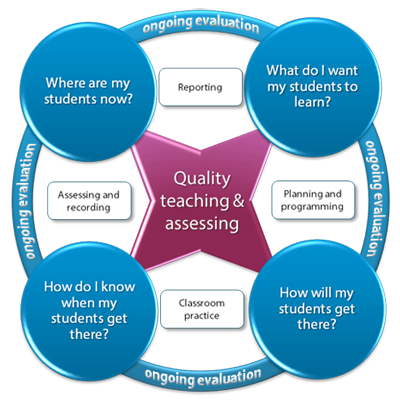Unit of learning
Writing the unit of learning
|
|
Seven hours of this course are allocated to the creation of a unit of learning. |
|
|
Refer to the document Curriculum planning and programming for quality teaching, assessing and reporting (.pdf 251kB) to refresh your understanding of key programming concepts. Work through the four stages of the teaching and learning cycle on the next tab to develop your unit of learning. This will enhance your understanding of assessment and reporting. |
|
|
The BOS NSW Program Builder tool allows you to program directly from the NSW syllabuses. |
The teaching and learning cycle
|
The teaching and learning cycle represents the four stages that occur in the design and delivery of classroom tasks that incorporate an outcomes-based approach. The cycle has no start or end point, with each step informing the next through ongoing evaluation. It is the process of gathering data and reflection that dictates where in the cycle you need to be operating. To complete your unit of learning, start by clicking on Where are my students now? and work clockwise around the diagram. |
 |
Indicative time: 7 hours
What is this tab about?
This tab focuses on the teaching and learning cycle to guide the process for writing a unit of learning. You may need to refer to Curriculum planning and programming for quality teaching, assessing and reporting (.pdf 251kB) to refresh your understanding of key programming concepts.
Delivery
-
Read the information on each tab on this page.
-
On the Teaching and learning cycle tab discuss how the teaching and learning cycle represents the four stages that occur in the design and delivery of classroom tasks that incorporate an outcomes-based approach. The cycle has no start or end point, with each step informing the next. It is the process of gathering data and reflection that dictates where in the cycle you need to be operating.
-
Discuss each question. Click on each question in the diagram to explore further. See table below for further instructions.
|
Question |
Focus |
Delivery |
|
Where are my students now? |
How learning can be differentiated to meet the needs of particular students. |
|
|
What do I want my students to learn? |
Using syllabus documents as well as a scope and sequence plan to determine allocated outcomes and content. |
|
|
How will my students get there? |
Outlines the key elements for writing the unit of learning. It focuses on the quality learning experiences necessary to achieve your teaching focus i.e. What you want your students to learn? |
|
|
How do I know when my students get there? |
Outlines the key elements for assessment. |
|
Completing the activity
The teaching and learning cycle provides an opportunity for participants to discuss each question and work individually or as a group.
Your unit of learning will include details about:
-
time frame
-
teaching and learning strategies and activities
-
resources and assessment
-
variations from the planned teaching program
-
registration and evaluation
-
differentiation

